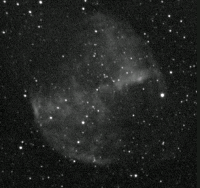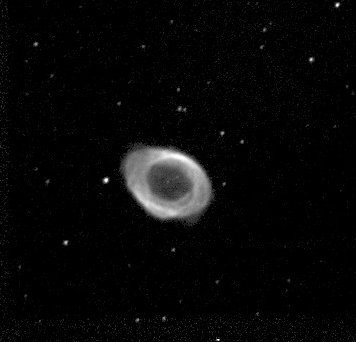
Whenever we talk to members of the university and the community and describe the Lynch Observatory, they always ask "What can you see from Philadelphia?" The answer is,"plenty!" In 1784, Charles Messier started a catalog of all of the nebular objects in the night sky, and that catalog, now known as the Messier catalog now numbers 108 of the most interesting objects in the night sky.
This was taken while checking the alignment and tracking of the drives, after we updated the firmware. We still need to work on the tracking, but I was able to get a decent picture anyway...
Taken 2007-09-02, John Parejko
The dumbbell is a so-called "planetary nebula," named because they looked very much like planets to the early telescope astronomers. They are actually old stars whose atmospheres have drifted off. The remains of the star---a white dwarf---are visible as the bright point in the center of the image. This is a 60s total image, from 6, 10s frames, all taken with the R band of the new UBVRI filters. Unfortunately, the nebula is probably brightest in h-alpha, and these filters are not that sensitive to particular wavelength.
A new DUMP image, taken on the same night as M 67 below. This is a black and white image, as I was trying to get as much light from the galaxies as possible (using filters reduces the amount of light recieved).
Taken 2006-04-18, John Parejko
M 105 is the round elliptical on the right, NGC 3384 is the more ovoid elliptical to the lower left, and NGC 3389 is the irregular spiral to the upper left. NGC 3389 is probably a background object, but the other two are members of the Leo I galaxy group. This is a combination of 7, 10 second frames per galaxy. You can where the frames transition by looking at the noise level, though I've tried to mask that out by rescaling for this image.
Fourth DUMP image, this time in color. The stars have a bluish tint because they are hot and young.
Taken 2006-04-18, John Parejko
A tight, young open cluster, which is very pretty to look at with the eye. I've had more luck with the filters now, and since these stars are relatively bright, I can get a very good stack of a large series of exposures. This is actually two separate frames, since the cluster is larger than a single frame. Each frame consists of 5xR, 7xG and 12xB, 3 seconds each.
Third DUMP image (I did say "soon to follow!")
Taken 2005-10-17, John and Ryan
A rather small, relatively dim (compared to the famous M13 and M15) globular cluster, M 56 lies in Cygnus, the swan. swarp allows several image recombining methods, and the chi^2 technique works well for dense star fields with a noisy background, as this one was.
Second DUMP image (third very soon to follow)

Taken 2005-10-17, John and Ryan
This is M 57, the famous Ring nebula in Lyra. It is a (hopefully) properly stacked set of 4 10s exposures. I think I've now wrangled wcstools and sextractor into control, so I should be able to produce a lot more of these, and make some much longer total integrations. There is a dim spiral galaxy which resides just off the upper-right of this image, but is only barely visible in my images.
First DUMP image! Click on it for a bigger version.
Taken 2005-09-12, John Parejko
This is M29, an open cluster in Cygnus. The image is a stack of three 10 second exposures and rescaled to 200%. It has not been flat-fielded and only a very simple dark frame was applied. I didn't notice when I was imaging, but I think some of the stars saturated (or nearly saturated) the CCD. Oops! Next time I'll remember to plug in the color wheel, so I can get RGB frames and stack those...
The Joseph R. Lynch Observatory has been made possible by the Generosity of Joseph R. Lynch '58 and the GE Foundation.